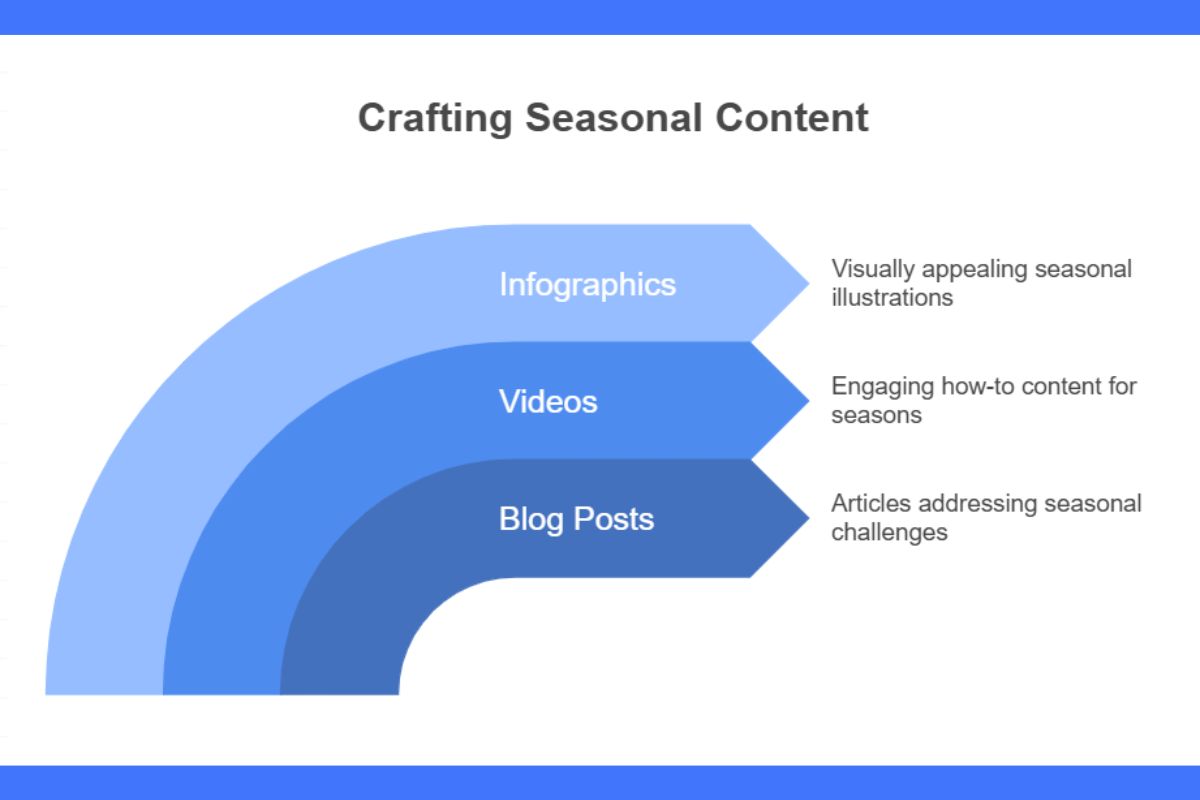Ever notice how your favorite coffee shop starts pushing pumpkin spice everything the moment September hits? That’s seasonal marketing in action – and the same smart thinking applies to your website’s search visibility. Seasonal SEO is about catching those predictable waves of customer interest and riding them to business success.
Here’s the thing: while regular SEO builds your foundation, seasonal SEO helps you capitalize on those moments when people are actively searching for what you offer. Whether it’s “holiday gifts for mom” in November or “summer vacation rentals” in March, timing your content right can mean the difference between being found and being forgotten.
This guide will walk you through everything you need to know about using seasonality to boost your search rankings when it matters most. You’ll discover how to spot trends before your competitors do and turn those seasonal traffic spikes into real revenue.
What Is Seasonal SEO?
Think of seasonal SEO as your website’s way of speaking the same language your customers are using at any given time of year. Unlike traditional SEO, which focuses on consistent, year-round traffic, seasonal SEO zeroes in on those predictable moments when search interest explodes around specific topics.
These moments aren’t random – they follow patterns we can all recognize. Christmas shopping starts earlier every year (seriously, I saw decorations in stores in October). Back-to-school season hits parents’ wallets hard in August. Tax season makes everyone scramble in March and April. Summer vacation planning kicks into high gear around February when people are dreaming of escaping winter.
Here’s where it gets interesting for businesses: a smart retailer doesn’t just wait for Black Friday to happen – they start optimizing their content months in advance. A tax preparation service begins targeting “tax filing help” keywords in January, not March, when everyone’s panicking. This forward-thinking approach, similar to the comprehensive SEO strategies used by successful businesses, helps you capture traffic before the competition heats up.

The real magic happens when you anticipate your customers’ needs and have the perfect content waiting for them. Instead of scrambling to create a Valentine’s Day gift guide on February 13th, savvy businesses have that content live and optimized weeks in advance.
What Are Seasonal Keywords?
Seasonal keywords are like fashion trends – they have their moment to shine, then fade into the background until next year. While evergreen keywords like “how to lose weight” get steady searches year-round, seasonal keywords like “Christmas cookie recipes” or “summer workout routines” experience dramatic spikes during specific periods.
The trick is recognizing these patterns before they peak. I’ve seen businesses miss out on thousands of potential customers simply because they started their keyword research too late. By the time they got their content live, the seasonal wave had already crested and crashed.
What makes seasonal keywords particularly valuable is their intent. When someone searches for “Mother’s Day gifts” in April, they’re not just browsing – they’re ready to buy. This high commercial intent means seasonal keywords often convert better than their evergreen counterparts, even if they don’t have the same search volume year-round.
Smart businesses track these patterns using tools like Google Trends, but here’s what most people miss: the data from previous years isn’t just interesting – it’s predictive. That spike in “pool supplies” searches that happened in April last year? It’s probably going to happen again this April. And now that you know about voice search SEO becoming more important, consider that people often speak seasonal queries differently than they type them – “near me” searches spike during holiday shopping seasons.
What Is Seasonal Content and How to Create It?
Creating seasonal content that actually works requires more than just slapping “Christmas” in front of your regular blog post titles. The best seasonal content solves specific problems your audience faces during particular times of the year.
I’ve noticed that successful seasonal content often falls into three categories: preparation content (what to do before the season hits), peak-season content (what to do during the event), and wrap-up content (what to do after). For instance, a financial advisor might create “How to Budget for Holiday Expenses” in October, “Last-Minute Tax Deductions” in December, and “New Year Financial Resolutions That Actually Work” in January.
The key is using your SEO metrics from previous seasons to understand what worked. Which seasonal articles drove the most traffic? What seasonal keywords brought visitors who actually converted? This data becomes your roadmap for creating even better content next time around.
Here’s something most businesses get wrong: they create seasonal content and then abandon it after the season ends. Instead, smart businesses use that off-season time to update and improve their seasonal pages. That “Best Summer Vacation Destinations” post from last year? Update it with new locations, fresh photos, and current pricing information. When summer rolls around again, you’ll have content that’s both established (Google trusts it) and current.
Your seasonal content should include:
- Blog posts that address seasonal pain points
- Resource pages for seasonal planning
- Updated product descriptions that reflect seasonal use cases
- Video content showing seasonal applications
- Local seasonal content that captures “near me” searches

Why Seasonal SEO Is Important?
The numbers don’t lie: businesses that nail their seasonal SEO strategy see dramatic traffic and revenue spikes during peak seasons. But here’s what’s really interesting – the benefits extend far beyond those obvious busy periods.
When you consistently show up for your customers during their seasonal moments of need, something powerful happens: you build trust and authority. How SEO strengthens your brand becomes clear when customers start thinking of you as the go-to resource for seasonal advice and products.
Consider this real-world example: a local landscaping company that creates seasonal content about fall cleanup, winter preparation, spring planting, and summer maintenance doesn’t just capture seasonal searches – they position themselves as the local expert. When a homeowner has a landscaping emergency in the middle of July, guess who they’re going to call?
The SEO impact on seasonal businesses goes beyond just traffic numbers. Seasonal SEO helps you:
- Capture high-intent customers when they’re ready to buy
- Build brand awareness during peak interest periods
- Establish authority in your niche through timely, relevant content
- Create multiple touchpoints throughout the customer journey
- Maximize the lifetime value of customers by staying relevant year-round
Here’s something most people overlook: seasonal SEO also helps you weather economic downturns. When discretionary spending drops, businesses that have diversified their seasonal presence across multiple times of the year are less vulnerable than those that depend on just one busy season.
Benefits of Seasonal SEO for Both B2C and B2B
The beauty of seasonality in SEO is that it works differently but effectively for both consumer and business markets. B2C companies get the obvious benefits – more visibility during shopping seasons, higher conversion rates from motivated buyers, and the ability to capitalize on impulse purchases during peak emotional periods like holidays.
But B2B seasonal SEO is where things get really interesting, and where most companies miss huge opportunities. Business decision-making follows predictable seasonal patterns, too. Budget planning happens in Q4 for the following year. New initiatives often launch in Q1. Mid-year reviews in Q2 and Q3 can trigger new vendor searches.
A software company that creates content around “Q4 budget planning for IT departments” or “New year, new tech stack” can capture B2B buyers during their natural decision-making cycles. Professional services firms see spikes in demand around tax season, fiscal year-ends, and compliance deadlines.
Key Benefits for B2C:
- Higher conversion rates during emotional buying periods
- Increased brand visibility during competitive shopping seasons
- Opportunities to capture impulse and gift purchases
- Natural content themes that resonate with consumer mindsets
Key Benefits for B2B:
- Alignment with business planning cycles and budget periods
- Positioning during natural vendor evaluation times
- Authority building through timely business insights
- Lead generation during decision-making windows

The companies that thrive with seasonal SEO understand that B2B seasonality often runs counter to B2C patterns. While consumers might slow down purchases in January after holiday spending, B2B companies are just starting their annual planning and have fresh budgets to spend.
How Seasonal SEO Can Affect Both B2C and B2B
Let’s be honest – seasonal SEO isn’t all upside. The same patterns that create opportunities also create challenges, and businesses that don’t plan properly can find themselves on a frustrating roller coaster of traffic and revenue.
The biggest trap I see companies fall into is putting all their eggs in the seasonal basket. A Halloween costume retailer that only focuses on October traffic, or a tax service that only creates content for April, leaves money on the table eleven months of the year. Worse, they become completely dependent on nailing one perfect seasonal moment.
Competition intensifies during peak seasons, too. Those “Christmas gift” keywords that seemed reasonable to target in July become battlefield territory by November. Established brands with bigger budgets can quickly push smaller companies out of visibility during the times when traffic matters most.
B2B companies face a different but equally challenging problem: their seasonal patterns might not align with when they actually want to sell. A conference planning service needs to capture attention in January for events happening in Q3 or Q4. The disconnect between when customers are searching and when they’re actually ready to buy requires careful nurturing and longer-term thinking.
Here’s where many businesses trip up: they create great seasonal content but fail to build the year-round authority needed to rank for competitive seasonal terms. Google doesn’t just reward seasonal relevance – it rewards overall site authority and trust. A brand new website trying to rank for “Black Friday deals” is fighting an uphill battle against established retailers with years of SEO history.
The solution isn’t to avoid seasonal SEO – it’s to build a balanced strategy that uses seasonal peaks to amplify your year-round efforts rather than replace them.
The Impact of Seasonality on SERPs
Search results become a completely different landscape during seasonal peaks, and understanding these shifts is crucial for maintaining visibility. Google’s algorithm doesn’t just consider relevance during seasonal periods – it actively prioritizes fresh, timely content that matches current user intent.
During major shopping seasons, you’ll notice that search results shift dramatically. Pages that ranked well in August might disappear from the first page by November as Google prioritizes more seasonally relevant content. This isn’t a penalty – it’s Google responding to what users want to see.
What’s particularly interesting is how local seasonality affects search results differently in different regions. “Winter coats” might peak in October in Minnesota but not until December in Texas. Google’s algorithm accounts for these geographic differences, which means your seasonal SEO strategy needs to consider where your customers are located, not just when they’re searching.
The rise of featured snippets and voice search has added another layer to seasonal SERPs. During peak seasons, Google often prioritizes quick, actionable answers in featured snippets. A query like “how long to cook Christmas turkey” is likely to trigger a featured snippet rather than traditional organic results.
Key changes during seasonal peaks:
- Fresh content gets prioritized over older, established pages
- Local and geographic signals become more important
- Featured snippets favor practical, seasonal advice
- Shopping results and product listings dominate commercial queries
- Mobile results emphasize location and immediacy
Smart businesses monitor their rankings more closely during seasonal periods and make quick adjustments. The companies that succeed are those that view seasonal SERP changes as opportunities rather than obstacles.
Planning Seasonal and Holiday SEO for Maximum Impact
The difference between businesses that succeed with holiday SEO and those that struggle often comes down to one word: timing. The companies crushing it during Black Friday started their content planning in July, not October.
Effective seasonal planning starts with understanding your customer’s timeline, not your business timeline. While you might think the Christmas shopping season starts in November, savvy shoppers are already researching gift ideas in September and October. Early-bird vacation planners are booking summer trips in February and March.
Here’s a framework that works: Start planning your seasonal content 3-4 months before you think customers will need it. Create your content calendar using tools like Google Trends to understand when interest starts building, not when it peaks. Most businesses create content for the peak, but the real opportunity is in capturing that growing interest before the competition notices.
Your seasonal SEO tips should include technical preparation too. Seasonal traffic spikes can crash unprepared websites, and there’s nothing worse than ranking #1 for a valuable seasonal keyword only to lose conversions because your site can’t handle the traffic.
Successful seasonal planning includes:
- Content creation 3-4 months in advance
- Technical infrastructure testing for traffic spikes
- Mobile optimization (seasonal shoppers are often on their phones)
- Local SEO optimization for “near me” seasonal searches
- Social media coordination to amplify your seasonal content
- Email marketing sequences that support your seasonal SEO efforts
The businesses that get this right don’t just see seasonal traffic spikes – they see compound growth year over year as their seasonal authority builds with Google and their audience.

FAQ
How do seasonal keywords differ from evergreen ones?
Seasonal keywords experience predictable surges in search volume during specific times (like “Halloween costumes” in October), while evergreen keywords maintain steady search volume year-round (like “home improvement tips”). The key difference is in timing and commercial intent – seasonal keywords often indicate higher purchase intent during their peak periods.
What industries benefit most from seasonal SEO?
Retail, e-commerce, travel and tourism, event planning, financial services (especially around tax season), home services, and any business tied to holidays, weather patterns, or recurring life events see the biggest benefits. However, even traditionally “non-seasonal” B2B industries have seasonal patterns in decision-making and budget cycles.
How soon should I start planning my holiday SEO strategy?
Begin planning 3-6 months before your target season. Content creation should start at least 2-3 months in advance to give it time to gain authority and rankings. The earlier you start, the better positioned you’ll be when seasonal competition intensifies.
Your Next Steps
The businesses winning with seasonal SEO aren’t using secret tactics – they’re just thinking ahead and putting their customers’ needs first. Start planning your seasonal content 3-4 months in advance, focus on solving real problems during peak times, and remember that consistency beats perfection.
Whether you’re targeting holiday shoppers or B2B decision-makers during budget season, the formula is simple: anticipate when people will need you, be there with helpful content, and build enough trust that Google puts you in front of them when it matters.
For businesses ready to implement these strategies systematically, partnering with experts like Indexed Zone SEO can help turn seasonal opportunities into year-round growth.



